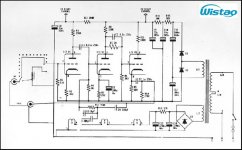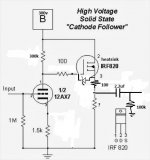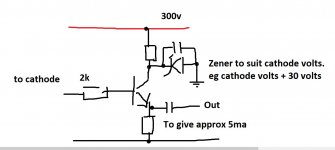hi
I build the EAR834 phono base 12ax7 tube.
i want to connected this phono stage to my single ended power amp
i order 20kohm ALPS RK27 for put between the phono and the power amp.
when i plug the POT, the high frequency is disappeared, its because the capacitance of the amp.
I would appreciate for recommendations for simple buffer
I build the EAR834 phono base 12ax7 tube.
i want to connected this phono stage to my single ended power amp
i order 20kohm ALPS RK27 for put between the phono and the power amp.
when i plug the POT, the high frequency is disappeared, its because the capacitance of the amp.
I would appreciate for recommendations for simple buffer
Attachments
Is the 20k pot located inside the power amp, or inside the phono stage?
How long is the RCA cable connecting them together?
How long is the RCA cable connecting them together?
Isn't 20k (and you also have the 47k on the power amp) going to be to low an impedance for that preamp to drive?
I also don't have a figure for the gate/source capacitance of those VFET's but suspect that is a major player here and is rolling the HF off in combination with the high output impedance of the preamp.
I also don't have a figure for the gate/source capacitance of those VFET's but suspect that is a major player here and is rolling the HF off in combination with the high output impedance of the preamp.
right after the phono stage, but its only for testingIs the 20k pot located inside the power amp, or inside the phono stage?
2mHow long is the RCA cable connecting them together?
yess.suspect that is a major player here and is rolling the HF
Before building a buffer, try placing the phono stage and the amplifier very close together,
and use very short cables to connect them. Now see if there is still a problem.
If not, the cables are at fault.
and use very short cables to connect them. Now see if there is still a problem.
If not, the cables are at fault.
yes its work😱try placing the phono stage and the amplifier very close together,
change to sort cable
Many thanks
Attachments
Last edited:
A buffer would need a low capacitance input... how about an emitter follower built into the preamp. Perhaps a simple Zener regulated supply, say 30 volt and with say 10ma or less current draw. Use a suitable transistor with the base fed off the cathode of the final stage and take the output via a cap from the emitter. Select the emitter resistor to pass say 5 milliamps.
It's the wrong end of the day here for this 🙂 but the above might work well. Add a little series resistance to the base feed for the transistor... would it diode protection... maybe not. Its very simple but should work.
It's the wrong end of the day here for this 🙂 but the above might work well. Add a little series resistance to the base feed for the transistor... would it diode protection... maybe not. Its very simple but should work.
yes its work😱
change to sort cable
Many thanks
I was to late 🙂 Good to know you found a solution.
yes its work change to sort cable
What kind of cable is that? It must have rather high capacitance/ft.
Just saying … ½ of the V₃ really is a buffer. So, that part doesn't need to be enhanced with another buffer. Y'know? As to the type of cable, sure … reducing cable capacitance is helpful. However, if you could squeeze in the drawing where you placed the ALPS pot, that would also aid our friendly discussion of the best quick-fix to perform.
⋅-⋅-⋅ Just saying, ⋅-⋅-⋅
⋅-=≡ GoatGuy ✓ ≡=-⋅
⋅-⋅-⋅ Just saying, ⋅-⋅-⋅
⋅-=≡ GoatGuy ✓ ≡=-⋅
i build this buffer(see attached)A buffer would need a low capacitance input... how about an emitter follower built into the preamp. Perhaps a simple Zener regulated supply, say 30 volt and with say 10ma or less current draw. Use a suitable transistor with the base fed off the cathode of the final stage and take the output via a cap from the emitter. Select the emitter resistor to pass say 5 milliamps.
but it make noisy, So I gave up, but now it works even without it 😕
what is your recommendation for POT place? thanksJust saying … ½ of the V₃ really is a buffer. So, that part doesn't need to be enhanced with another buffer. Y'know? As to the type of cable, sure … reducing cable capacitance is helpful. However, if you could squeeze in the drawing where you placed the ALPS pot, that would also aid our friendly discussion of the best quick-fix to perform.
Attachments
Last edited:
20k is too low, the preamp doesn't like that. The output cathode follower is made with a 12AX7 and cannot deliver much current. I would use a 250k potmeter or higher and put it close or inside the power amp.
i build this buffer(see attached)
but it make noisy, So I gave up, but now it works even without it 😕
The buffer would use a normal transistor, not a power FET so as to reduce capacitive loading.
It would also takes its signal from the cathode (where the output is now). The Zener voltage would be set to be a bit higher than the normal cathode DC voltage. The Zener gives a super clean supply and regulated supply and also reduces power dissipation in the transistor.
Edit... you could also look at the possibility of including the buffer within the feedback loop, in other words transfer the cathode connections to the emitter.
Attachments
thanks. i will try it.The Zener gives a super clean supply
can i switch to 12au7?20k is too low, the preamp doesn't like that. The output cathode follower is made with a 12AX7 and cannot deliver much current. I would use a 250k potmeter or higher and put it close or inside the power amp.
can i switch to 12au7?
Yes you can but 20k is still rather low.
- Home
- Amplifiers
- Tubes / Valves
- POT between EAR834 phono and power amp, buffer?



